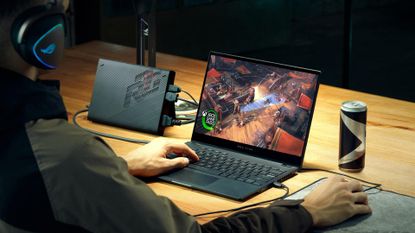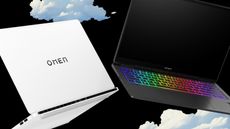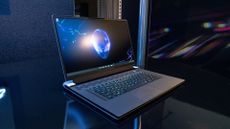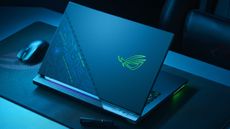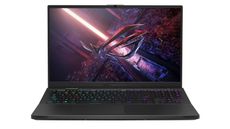When you are thinking of buying a laptop, it’s about choosing two out of three: size, speed, and battery life. You can get a pretty small laptop with a powerful processor, but the battery life will be short. Want a powerful gaming laptop? It will be big, bulky, and have a battery life measured in minutes. That’s how it usually works, at least.
However, the Asus Republic of Gamers Flow X13 tries to shift the rules by splitting the laptop into two parts: a small, portable laptop and an optional graphics processing unit (GPU). So, if you want to take the laptop on the road for work, you can leave the GPU part at home. When you get home and want to frag some parademons, you plug in the GPU and fire up Doom Eternal. It’s an interesting concept, but the reality is expensive and has some awkward quirks. So, let’s dig into the details of this interesting laptop concept.

Asus ROG Flow X13 review: Price and Release Date
The Asus ROG Flow X13 is available now, from $1,499 / £1,498. My review unit, with 16GB of RAM and the XG docking station with the RTX 3080 Laptop GPU is priced at $2,799.99 / £2,699.
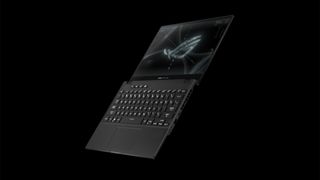
Asus ROG Flow X13 review: Features and Design
There are two parts to the Flow X13: the laptop and the XG docking station. Let’s take a look at the laptop first. It’s an attractive device, with a matte black case, a large, clear WXGA screen, and a good-sized keyboard. It weighs in at just under 3 lbs (1.3kg) and is 0.6 inches (1.58cm) thick, which makes it very portable. Flip the screen over, and it converts into a tablet, so it’s a true convertible, 2-in-1 device.
There are a decent number of connections available, including a USB-C, USB 3.2, and an HDMI port. There is no support for the newer Thunderbolt 3 or 4 standards, though. There is also a headphone socket and the custom port that the XG docking station connects to. The latter of these has a rubber cover over it that isn’t attached, which means I managed to lose it within about 30 seconds of opening the box. Sorry, Asus.
Under this elusive cover is the secret sauce that makes this laptop tick: a unique port that resembles a stretched USB-C port with a shedload more pins. This is where the XG Docking Station plugs in, adding the Nvidia RTX 3080 Laptop GPU to the system.
In technical terms, this port offers the same amount of bandwidth as a PCIe X8 port, about half of that offered by the PCIe X16 connection that a full graphics card in a desktop gaming PC uses. The XG is about the size of a paperback book and includes the GPU plus a power input, DisplayPort and HDMI outputs, gigabit Ethernet, and four more USB 3.2 ports.
The docking station only works when the power supply is connected, so you can’t use the external GPU away from a power socket. It does charge the laptop when connected, though, so the idea is that it sits on your desk at home where you play games, then you unplug the laptop to take with you and do some work.
You can’t just unplug the docking station and go, though: you have to first use the Asus RoG XG Mobile app to electrically disconnect the docking station, then throw the unlock switch on the top of the plug. The mobile app also closes any programs that are using the external GPU, which includes pretty much any program that uses graphics. That’s kind of a pain: most eGPU devices make the process simpler. The cable that connects the XG and laptop is also rather short: at just a foot long, the two parts have to be close to each other.
The idea of an external GPU (eGPU) device isn’t new: we’ve seen eGPU devices like the Razer Core that can handle a full-sized desktop graphics card and which plug into a Thunderbolt 3 port. These always have a limitation, though: you lose a small amount of performance by squeezing all of that graphics data through a Thunderbolt cable. The X13 tries to get around this by using its own proprietary connector that offers more bandwidth.
I found the keyboard of the Flow X13 to be comfortable to use, with a decent amount of travel to the large, LED-backlit keys. Dedicated buttons at the top of the keyboard control the volume, mute the microphone and kick off the ROG Armory Crate control software, which controls the GPU and other features. The touchpad is also large and was comfortable to use, and the textured design of the case provided a good spot for the wrists to rest on when typing.
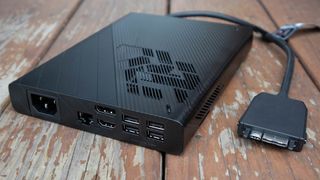
The external GPU
Asus ROG Flow X13 review: Screen and Speakers
The 13.4-inch screen of the Flow X13 is very bright, clear and sharp. It has WUXGA (1920 by 1200) resolution and a peak brightness of just under 300 Cd/m2. That means it is bright enough to use in all but direct sunlight, and I found myself turning down the brightness most of the time. It also has excellent color and dynamic range: the blood splatters in games like Doom Eternal looked vivid against the dark rocks and wreckage.
The speakers are also decent, with plenty of volume and decent bass, which is unusual for a laptop. The bass was a little flat, though – it lacks the oomph and thump that makes it feel you are really punching a parademon in the groin.

Asus ROG Flow X13 review: Performance and Software
Let’s get to the crux of the matter: does the Flow X13 offer the best of both worlds? Does it offer a lightweight laptop and desktop gaming power in one? It does, but the process involves a number of compromises that make it less flexible than hoped. It isn’t as fast as a dedicated gaming laptop or desktop, and it isn’t as small and light as an Ultra Lite laptop.
With the CG docking station connected, the X13 achieved an excellent 3D Mark Time Spy score of 10,340. It handled games like Doom Eternal and F1 2021 without straining. In Doom Eternal on the highest Ultra Nightmare graphics setting, it managed frame rates close to the maximum 120Hz refresh rate of the built-in display, and 160 frames per second on an external 240Hz monitor connected to the DisplayPort output. In other words, the games looked great, with very smooth, fluid motion. However, the laptop version of the RTX 3080 GPU that the Flow X13 uses doesn’t offer the same level of power as the desktop version, which regularly achieves scores of 12,000 and above.
With the docking station disconnected, the Flow X13 switches to the Nvidia GTX 1650 GPU built into the laptop, which managed a 3D Mark Time Spy score of 3,364. That’s a little better than most lightweight laptops, which rely on a GPU built into the CPU. We found that it had enough oomph to play Doom Eternal at around 60 fps on the high graphics settings at the native resolution of the built-in display. So, mobile gaming is possible, just not at the super-high resolution and frame rate that the XG Docking Station enables.

Asus ROG Flow X13 review: Battery Life
The Flow X13 includes a 62Wh battery that I found had decent battery life. Running the PC Mark 10 Video battery test, it lasted 9 hours and 2 minutes. That’s a very decent battery life that means it should last a day or so of work. The battery life when gaming would be significantly less, though: I found that about half an hour of playing Doom Eternal reduced the battery from 100% down to 63%. So, depending on the game you choose, the mobile gaming lifespan is likely to be no more than a couple of hours. Also, interesting to note is that the frame rate drops to 30fps when running on battery power.

Asus ROG Flow X13 review: Verdict
The RoG Flow X13 almost manages to achieve what it sets out to do: offer both desktop-level gaming at home, and decent gaming on the road. However, it falls a little short of this. The XG Docking Station uses a laptop version of the Nvidia GTX 3080 GPU that doesn’t offer the same performance as the desktop version. The process of disconnecting the external graphics card is also overly complex, forcing you to quit out of most programs so you can’t simply unplug and go.
The performance of the GPU built into the laptop is also decent, and the price isn’t bad for a gaming laptop. But it feels like an inadequate compromise. If you want all-out gaming performance at home, get a desktop PC. If you want all-out gaming performance that you can carry with you, get a dedicated gaming laptop and hope that you can find a power outlet. The Asus ROG Flow X13 tries to be a jack of all trades, but does not end up being the master of any.
Asus ROG Flow X13 review: Also Consider
The ROG Flow X13 is well priced for a gaming tablet, but it still ain’t cheap. If you have a smaller budget, consider the Asus ROG Zephyr G14. Costing about half as much as the X13, it uses the same built-in GPU and has a similar-sized screen.
If you want an all-in-one package, take a look at the Alienware Area51-M series. These powerful gaming laptops move the GTX 3080 GPU into the laptop itself, so you can have true powerhouse gaming on the go. They are bigger, heavier and have shorter battery lives than the X13, though.
If money is no object, the Asus ROG Zephyrus Duo 15 might be the one for you. This offers a large 15-inch screen, plus a smaller secondary screen above the keyboard for showing information like the GPU settings or weapon loadout. It does use a slower GPU than the Flow X13, though, with an Nvidia GTX 2080 graphics chip.
